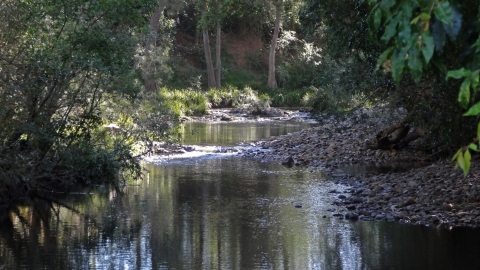As outlined in the Methodology for bioregional assessments of the impacts of coal seam gas and coal mining development on water resources (the BA methodology; Barrett et al., 2013), the development of a water-dependent asset register is integral to undertaking a bioregional assessment (BA). The BA methodology provides overarching principles for the generation of BAs and this submethodology applies those principles to the specifics of compiling water-dependent asset databases for BA purposes.
An asset is an entity having value to the community and, for BA purposes, is associated with a bioregion or subregion. A bioregion is a geographic land area within which coal seam gas (CSG) and/or coal mining developments are, or could, take place and for which BAs are conducted. A subregion is an identified area wholly contained within a bioregion that enables convenient presentation of outputs of a BA.
A water-dependent asset has a particular meaning for BAs; it is an asset potentially impacted, either positively or negatively, by changes in the groundwater and/or surface water regime due to coal resource development. Some assets are solely dependent on incident rainfall and will not be considered as water dependent if evidence does not support a linkage to groundwater or surface water.
The water-dependent asset register is a simple and authoritative listing of the assets within the preliminary assessment extent (PAE) that are potentially subject to water-related impacts. A PAE is the geographic area associated with a bioregion or subregion in which the potential water-related impact of coal resource development on assets is assessed. The compiling of the asset register is the first step to identifying and analysing potentially impacted assets, which is the goal of the overall BA.
The description of the water-dependent asset register (product 1.3) for each bioregion or subregion is available at http://www.bioregionalassessments.gov.au/. Any deviations from the approach described in this submethodology are to be noted in any products based upon its application.
The steps in creating the water-dependent asset register for a BA are explained in this submethodology and are as follows (Figure 3):
- Compilation and classification of national and other asset databases by the Assets and Receptors Project team to produce the asset database (see Section 2). A key input to the asset database at this stage is the BA-purpose-built Water Asset Information Tool (WAIT) database populated by natural resource management organisations (NRMs).
- Definition of the PAE for a bioregion or subregion by the Assessment team (see Section 3).
- Creation of an asset list by the Assets and Receptors Project team through selection of assets in the asset database that occur within the PAE (see Section 3).
- Refinement of the asset list by the Assessment team (based on the potential for water-related impacts on assets and feedback from experts with local knowledge) to create a water-dependent asset register (see Section 4).

Figure 3 Process for developing a water-dependent asset register for a bioregional assessment
The asset source data are compiled into an asset database, including the spatial data, which are designated as elements (individual spatial features – points, lines and polygons) and assets (combinations of one or more elements). During the compilation process, assets are classified into three groups: (i) ecological, (ii) economic and (iii) sociocultural. Many assets are obtained from state and national databases and a key group of assets is provided by NRMs. Meetings are planned with Indigenous knowledge holders to discuss Indigenous cultural water-dependent assets.
The asset database is then used to generate the water-dependent asset register. A preliminary version of the asset register is presented to experts and organisations with local knowledge at organised workshops. Feedback is sought about whether the asset register is complete and correct; appropriate amendments are then made. It is at this stage – when assets have been selected using the PAE and the amended water-dependent assets have been recorded in the database – that the water-dependent asset register is complete for the purposes of producing product 1.3. Note, however, that the addition of new assets to the asset database, or a review of the status of existing assets in the database will mean that the asset register may be updated. As this has implications for other BA components, any updates must be documented and only be done with approval and tight version control. The product 1.3 will not be updated or republished but an updated version of the asset register (derived from the asset database) may be published at the same time as other products, for example, those associated with Component 3: Impact analysis of a BA.
Following development of the asset register, the connection of the registered assets to coal resource development is assessed using the ‘materiality’ tests and, if potentially subject to water-related impacts, assigned receptors (after Barrett et al., 2013). A receptor is a point in the landscape where water-related impacts on assets are measured and/or estimated. The approach to assigning receptors and impact variables to water-dependent assets is described in the pending companion submethodology M03 (as listed in Table 1).
References
Barrett DJ, Couch CA, Metcalfe DJ, Lytton L, Adhikary DP and Schmidt RK (2013) Methodology for bioregional assessments of the impacts of coal seam gas and coal mining development on water resources. A report prepared for the Independent Expert Scientific Committee on Coal Seam Gas and Large Coal Mining Development through the Department of the Environment. Department of the Environment, Australia. Viewed 20 November 2014, http://iesc.environment.gov.au/publications/methodology-bioregional-assessments-impacts-coal-seam-gas-and-coal-mining-development-water.

METHODOLOGY FINALISATION DATE
- 1 Background
- 2 Compiling the asset database
- 3 Determining and applying the preliminary assessment extent
- 4 Assessing water dependence of assets
- Appendix A Simple descriptions of key tables within the asset database
- Appendix B Identifying economic assets
- Citation
- Contributors to the Technical Programme
- About this submethodology
